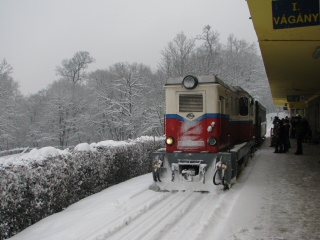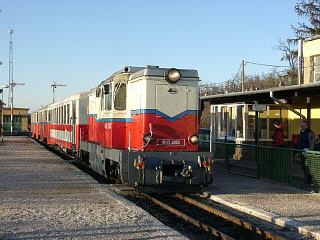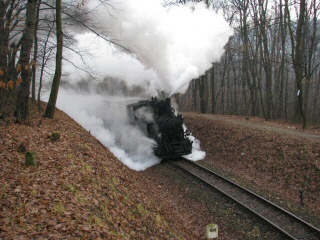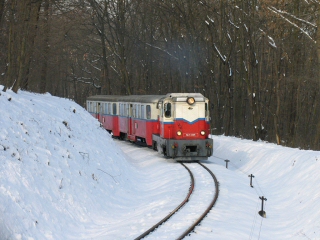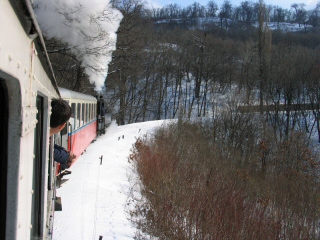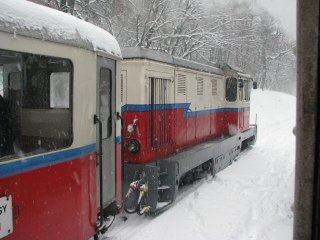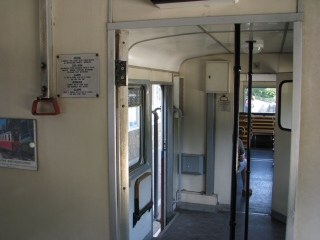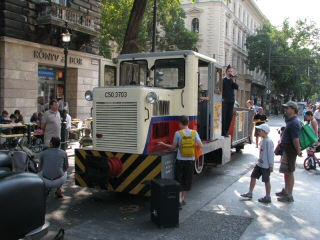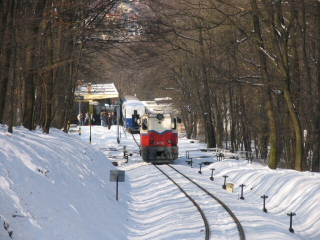budapest
other hungarian
close-up
lost rails
other countries
Hier geht's zur deutschsprachigen Version / Kattints ide a magyar változathoz
The narrow-gauge (760 mm) Children's Railway, built between April 11. 1948 and August 20. 1950 in three stages (Széchenyi-hegy - Virágvölgy, Virágvölgy - Szépjuhászné, Szépjuhászné - Hűvösvölgy) is more or less known to railway and tram enthusiasts visiting Budapest. Still, it's rather under-represented on my website, so I thought I share one or two pictures and short videos of it.
The best thing about this railway is, that it's anything but a children's toy! It's a real railway line with real stations using real-railway security mechanisms, with real trains running on a real timetable. Of the active staff, only station masters, engine drivers, guards, yard masters and stokers are grown-ups, the rest is done by the "children on duty".
The line itself is also very far from a park train: it's 12 kilometers long, has gradients up to 3%, with bridges and even a tunnel. Normal trains are towed by type L45H locomotives (left), heritage trains are towed by steam engines during the winter (right) and a Ganz diesel coach during summer.
And even though the line hasn't got real transportation purposes (one of its magic is that it avoids built-up areas while still running on Budapest territory), it still transports around 365,000 passengers annualy (which is still only about half of the figures of the 1960s). The Hűvösvölgy terminus (the name of the location translates to "Chill Valley") is located 230 meters (755 feet) above sea level, while the other one (Széchenyi-hegy, named after the "Greatest Hungarian", Count István Széchenyi) is at 466 meters (1,529 feet), which means there's quite an ammount of climbing to do, with nicely photographable bends like the two above.
At the start steam operation did not last long because the oil-heated steam engines were too weak for the job. The two steam engines used today were put in service recently: one (MÁVAG 490.056 built in 1950) was brought here from the Balatonfenyves narrow-gauge railway, where it was used as a tourist attraction, the other one (490.039, built in 1942) did see some service here in its younger days. They can hardly be called "powerful", but they're very nice :)
The Mk45-class (UIC designation 9555 2945) diesel-hydraulic engines were built by FAUR of Romania in the 1970s, and they aren't your usual narrow-gauge tractors - in fact they are pretty much the most "large diesel"-ish loking small diesels I've every seen (not counting the ex-Soviet TU2-engines).
This is not normal: two engines for just one coach! I guess one of the engines was towed to the other end of the line, but I bet the "horsepowers vs. number of passsengers"-ratio was somewhere in the league of a Shinkansen :)
More riding in the snow. Heritage coaches are heated by stoves, which adds to the atmosphere inside. During my childhood normal coaches were also heated like this, but nowadays they have central heating. And of course there are the open (summer) cars, but you won't see them during winter :)
To the left: the end of the line at Széchenyi-hegy, with the TV tower (built in 1957) in the background. To the right: the central entrance platform of a normal coach.
During the Days of Cultural Heritage/Car-free-day 2009, some of the more easily movable vehicles of the Children's Railway payed a visit in the inner city. They occupied a short stretch of Andrássy út (right above the "Kisföldalatti" or Milleneum Subway Line) with for example this railcar built out of a Skoda Tudor (to the left), or with the typical hungarian narrow-gauge railway tractor, the C50 (to the right).
But let's get back to the Buda hillsides: a steam-engine climbing out of Hűvösvölgy.
Four-car trains are relatively rare - I didn't expect to see one, hence the suboptimal quality of these two pictures. Normal trains (secpecially during the winter) have 1 or 2 cars, the rest here were probably chartered.
And we're now at the end of the page. I hope you liked this, and if you're visiting Budapest, consider taking a trip with this small but interesting operation. There's even a convenient way for rail enthusiasts to do this: first go up to Hűvösvölgy with tram 61, take a Children's Railway train to Széchenyi-hegy, and come down back to the city with the rack railway. It's like it was meant to be used this way :)
Back to the top Back to the main page
